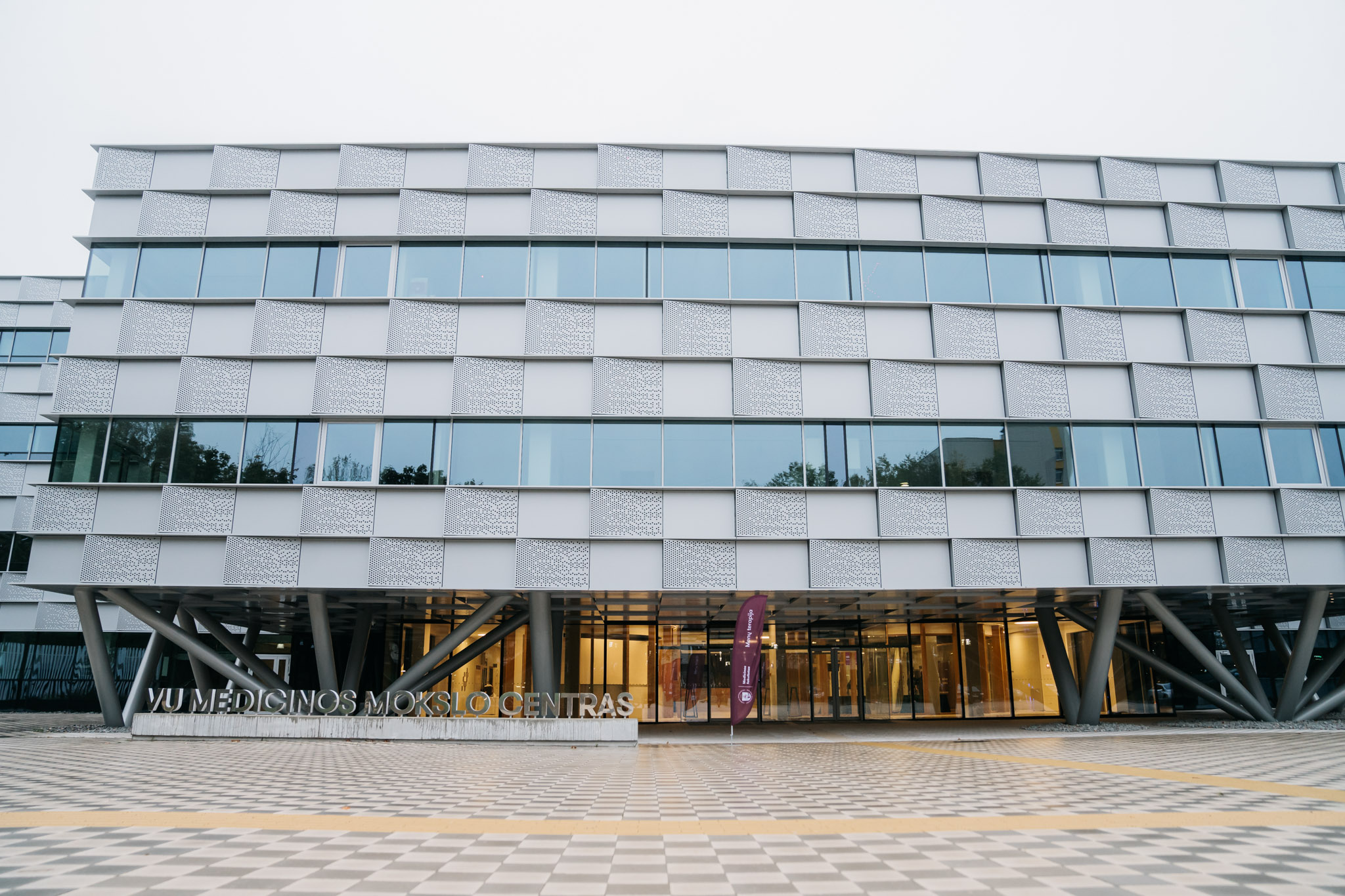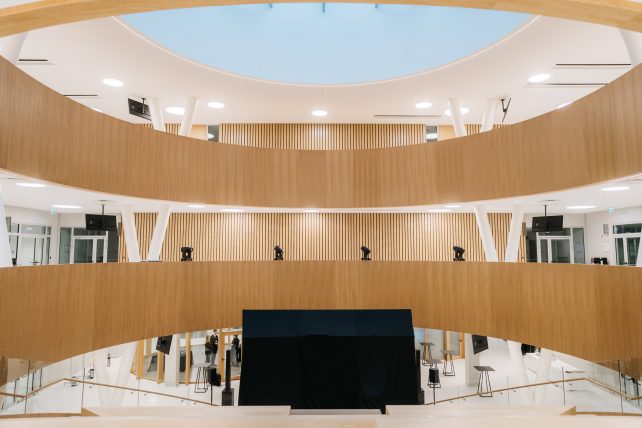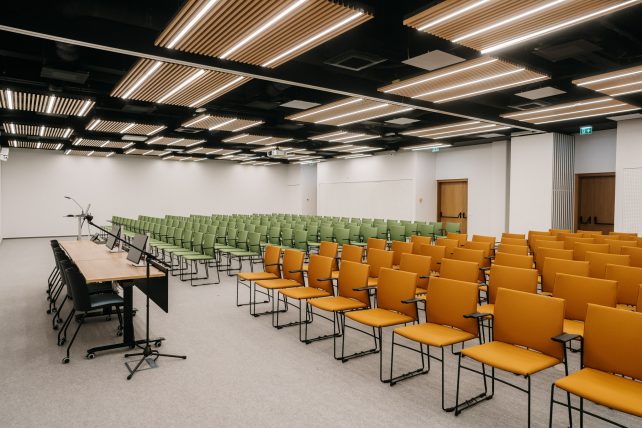From Organoid Cultivation to Digital Solutions for Fighting Cancer: The New Medical Science Centre Boasts Remarkable Innovations
 The Medical Science Centre of the Faculty of Medicine at Vilnius University (VU) was opened on 3 October 2024 in Santara Valley in Vilnius. This marks the most significant investment in medical education infrastructure in Lithuania’s independence history. The new Centre’s primary goal is to convert fundamental scientific discoveries into medical solutions for practical use.
The Medical Science Centre of the Faculty of Medicine at Vilnius University (VU) was opened on 3 October 2024 in Santara Valley in Vilnius. This marks the most significant investment in medical education infrastructure in Lithuania’s independence history. The new Centre’s primary goal is to convert fundamental scientific discoveries into medical solutions for practical use.
The new Medical Science Centre houses unique laboratories and research facilities. By leveraging diverse tools – from human cell cultivation and modern molecular research to digital innovations – it will focus on advancing translational, personalised, and digital medicine.
The Centre will host a range of genetic, biomarker research, neuroscience, dental, and other laboratories and will enhance the fight against cancer by employing AI tools developed and patented by its researchers. The Medical Science Centre complex also launched the country’s only population biobank – the Biobank of the Lithuanian Population and Rare Disorders – which is set to collect biological samples from the country’s population. The collaborative efforts of researchers working at the Centre are expected to significantly advance the development of personalised medicine in Lithuania.
This is just a fraction of the new Centre’s capabilities: the entire complex comprises six buildings and nearly 900 individual premises, all equipped with top-tier research amenities. The building spans an impressive area of 19,000 square metres and signifies a total investment of EUR 66 million, including EUR 36.6 million from the European Regional Development Fund.
The opening ceremony of the Medical Science Centre was attended by the Prime Minister, the Minister of Health, the Minister of Education, Science and Sport, the Vice-Minister of the Economy and Innovation, as well as a large community of medical scientists, politicians, and business representatives.
According to the participants of the opening ceremony, the Centre will elevate scientific activities to a new level of quality and contribute to achieving breakthroughs in medicine for the benefit of Lithuania and beyond.
‘The establishment of this innovative and much-needed Medical Science Centre reflects the abundance of talent and intelligence in the country, which is growing in strength and setting high-quality standards. The Centre’s state-of-the-art infrastructure, modern facilities, and location at the Santariškės Medical Campus will foster the synergy between cutting-edge research and clinical practice. This, in turn, will contribute to the development of innovation, more effective patient treatment, especially in the fight against rare and critical diseases, as well as the smooth transfer of knowledge to the next generation of specialists and researchers,’ said Ingrida Šimonytė, Prime Minister of the Republic of Lithuania.
‘Lithuanian science is rapidly developing, and our scientists are gaining international recognition. But we will definitely not stop here: to attract top talent to the science sector and advance research to new heights, we need to ensure superior working conditions and access to modern infrastructure. The State is making substantial investments for this purpose,’ remarked Radvilė Morkūnaitė-Mikulėnienė, Minister of Education, Science and Sport.According to Prof. Rimvydas Petrauskas, Rector of Vilnius University, the opening of this Centre marks a significant milestone in the University’s history.
‘We have established the Medical Science Centre to pursue excellence in both fundamental science and science-based clinical treatment. The opening of the Centre on this campus is crucial, as it is increasingly evolving into a place of both medical treatment and scientific research and studies. The key to unlocking success across all fields is the combination and integrity of science, studies, and their practical application. This is especially true in medicine, where scientific and treatment advancements have gained remarkable momentum,’ noted VU Rector Prof. Petrauskas.
According to Prof. Dalius Jatužis, Dean of the VU Faculty of Medicine, the new Centre’s greatest strength is that it brings together the leading specialists and clinical scientists from different medical disciplines.
‘By locating the Centre in Santara Valley, close to all key medical institutions involved in the treatment and care of the most complex patients, along with the country’s first population biobank, we are filling the gap in the ecosystem and establishing ourselves as its vital link that was missing until now,’ said Prof. Jatužis, who explained that ‘the equipment is not the most important factor here. In Lithuania, we already have quite abundant and high-value tools. First, we need focused minds dedicated to a clear objective. I believe this is the most crucial element of the Medical Science Centre: we have gathered experts from diverse fields of medicine who will also work with clinical practitioners. I have no doubt this will give a major boost to one of the strategic goals of medical research – to convert scientific discoveries into medical solutions for practical use.’
According to Assoc. Prof. Dr Karolis Ažukaitis, Vice-Dean for Research and Innovation at the VU Faculty of Medicine, researchers and medical staff will come together, united under the aim of integrating scientific research into practical medicine.
‘We will try to ‘broadcast’ from the laboratory to the patient’s bedside and back, seeking to apply the scientific discoveries made in our laboratories directly to patient treatment and then bring the results back to the laboratory for further research and development. This reflects the essence of translational research, where scientific discoveries are converted into practical treatment solutions for health improvements,’ added Assoc. Prof. Dr Ažukaitis.
The biobank to enhance insights into the health of Lithuania’s population
The new Centre will carry out comprehensive research in various fields of medical science and develop cutting-edge tools to improve treatment effectiveness for severe diseases and promote preventive healthcare.
The Centre for Applied Neuroscience will conduct sleep studies in controlled environments isolated from noise pollution and record various changes in the body’s activity during sleep. State-of-the-art equipment will also be used to perform live brain research, including assessments of cognition, motor functions, brain bioelectricity, and blood circulation. This will enhance the understanding of early changes in brain function amidst disease progression.
Research on population genetics, human genomics, and gene regulation will be carried out in a number of different genetic research laboratories. Based on a wide range of innovative and advanced molecular techniques, biomarker research will also contribute to more accurate disease diagnosis and prediction.

Moreover, the new Centre houses the country’s first Biosafety Level 3 (BSL-3) Laboratory, which will allow research on highly contagious and hazardous agents. For safety purposes, the specialists on-site will wear full-body protective clothing and work in a fully isolated, pressure-controlled environment.
The establishment of the Medical Science Centre also coincides with the creation of the country’s first Paleogenetics Laboratory – a hub for studying DNA from ancient plants, micro-organisms, and even human bones and other preserved tissues. For instance, this laboratory will be used for researching the genetic, nutritional, and health characteristics of partisans, Napoleonic soldiers, and ancient nobles.
The new Centre will also host the Biobank of the Lithuanian Population and Rare Disorders, which will serve as a repository for biological samples from the research participants, such as blood, saliva, skin, urine, tissue biopsies, and other health and lifestyle data.
The country’s first population biobank, along with the other biobanks established in Lithuania, is part of the international BBMRI-ERIC network. The new facility will help us better understand the health characteristics of the Lithuanian population in today’s context as well as the impact of genetic and environmental factors and lifestyle on disease onset and progression. Using biological samples from the current Lithuanian population, the biobank will conduct extensive biomedical research and systematically collect information on the health and risk factors of healthy Lithuanian residents. According to Dr Giedrė Kvedaravičienė, Director of the Biobank of the Lithuanian Population and Rare Diseases, combining this information with the samples and data of patients with oncological, genetic, and other diseases collected by other Lithuania’s biobanks will pave the way for personalised medicine in the country.
‘Our biobank will fill a critical niche in the field of biobanking by supplementing the samples collected by other members of the Lithuanian National Biobanking Consortium with a consistent collection of healthy population samples and data. Through long-term studies, we will collect data on the genetic basis, risk factors, and mechanisms behind major health issues in Lithuanian society. All this is set to create the missing tools for medical innovation and help promote personalised medicine as a standard practice in our country,’ stated Dr Kvedaravičienė.
According to the Director of the new biobank, different nations are genetically diverse and exhibit significantly unique characteristics, as illustrated by international and Lithuanian research. ‘Therefore, thoroughly collected high-quality population data and national medical practice based on it, with a personalised approach to both disease treatment and prevention, can have a major influence on public health. For example, it may help us explore the reasons behind Lithuania’s alarming rates of cardiovascular diseases and its status as one of Europe’s most affected nations. The population-based biobank collection of comprehensive health data will allow us to make recommendations for risk factor assessment. This will help general practitioners identify high-risk patients earlier and more accurately as well as enhance disease prevention and treatment,’ said Dr Kvedaravičienė.
Organoids to be cultivated at the Medical Science Centre
Another promising medical science innovation to be developed at the new Centre is that teams of scientists will employ advanced technologies to grow organoids, i.e. small versions of human organs, using pluripotent stem cells. The cultivation of organoids is a complex and challenging process. Thus, the collaborative efforts of experts with high scientific proficiency and their leading international colleagues are expected to help achieve breakthroughs in this field.
‘Yes, we have both the necessary tools and the capabilities for organoid cultivation and research at the Medical Science Centre,’ claimed Dr Andrius Kaselis, a neuroscientist and Senior Development Specialist from the Medical Science Centre at the VU Faculty of Medicine.
‘An organoid must accurately reflect the functional and structural characteristics of an existing organ, ensuring the viability and functional capability of the cellular composition within that organ. Currently, the development of this technology and organoid cultivation methods are the focus of a huge amount of effort and investment worldwide as it is one of the ways to minimise animal testing in the development of pharmaceuticals. Research in this field can be enhanced through the cultivation of the right organoid as a more efficient alternative to animal testing. Therefore, one of the key areas where organoids can be used is pharmaceuticals,’ explained Dr Kaselis.
Another important field is cancer research.
‘Suppose we take a sample of a malignant tumour from a patient and grow it in vitro – by analysing its structure and properties in detail, we can much more easily and quickly unlock answers on how this particular tumour should be treated in real life. Meanwhile, destroying a tumour without a precise understanding of its structure and potential responses can be extremely challenging,’ added the neuroscientist.
Developing computer algorithms for disease course prediction: embracing the age of precision medicine
The new medical science complex also houses the Centre for Digital Medicine, which is expected to bring together data and medical scientists and contribute to the introduction of AI technologies to the healthcare system.
According to Arvydas Laurinavičius, Director of the National Center of Pathology and Professor at the VU Faculty of Medicine, digital medicine is a very broad field, ranging from health information standards and data and process management to machine learning and the implementation of AI systems in clinical practice. According to the Professor, modern medicine is undergoing a global digital shift with rapid advancements across its various fields.
‘This Centre will help us develop an open ecosystem that will bring together machine learning researchers from the VU Faculty of Medicine. Interaction between different specialists, as well as the easy and secure access to and processing of quality data, are key to success. Health data is obtained during the clinical process, so it is crucial to improve the current information systems and, at the same time, unleash the power of AI systems. In other words, we will strive to be both system developers and users. It will also be a place for students of all disciplines and study cycles to express themselves – working in a digital environment breaks down the boundaries of time, space, and imagination,’ said Prof. Laurinavičius.
According to him, the research groups at the VU Faculty of Medicine, together with their partners, are also developing algorithms and new digital tools. For instance, the developed immunogradient – the digital pathology algorithm – allows researchers to assess the spatial distribution of lymphocytes in the interface between the cancer cells and the host tissue and to forecast disease progression. ‘This algorithm enables us to measure whether a patient’s immune cells – lymphocytes – are penetrating deeper into the cancer tissue within the tumour microenvironment; that is to say, to evaluate the drive and determination of lymphocytes in their fight response. It appears that such spatial measurements strongly correlate with a patient’s prognosis. We have already been granted US patent approval for this method, and the European assessment is pending,’ remarked Prof. Laurinavičius.
While pathological data is highly comprehensive (one square millimetre of microscopic image can hold one CT scan), even greater value is achieved through the combination of diverse types of information (multimodal data). ‘For example, machine learning that integrates data from various sources, including pathology, laboratory work, radiology, disease clinic data, the workflow, and response to treatment, enhances the quality of AI systems. All of this will benefit us in the era of precision medicine,’ concluded the researcher.